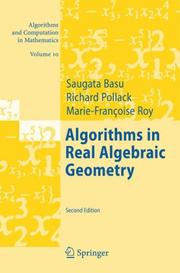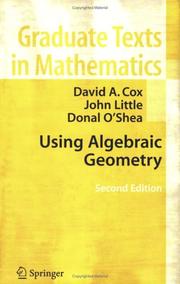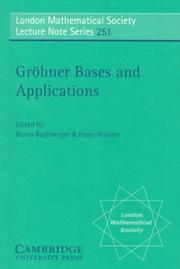| Listing 1 - 8 of 8 |
Sort by
|
Book
ISBN: 9783319462097 3319462091 3319462083 Year: 2017 Volume: 2172 Publisher: Cham: Springer,
Abstract | Keywords | Export | Availability | Bookmark
 Loading...
Loading...Choose an application
- Reference Manager
- EndNote
- RefWorks (Direct export to RefWorks)
Providing an overview of the state of the art on rationality questions in algebraic geometry, this volume gives an update on the most recent developments. It offers a comprehensive introduction to this fascinating topic, and will certainly become an essential reference for anybody working in the field. Rationality problems are of fundamental importance both in algebra and algebraic geometry. Historically, rationality problems motivated significant developments in the theory of abelian integrals, Riemann surfaces and the Abel-Jacobi map, among other areas, and they have strong links with modern notions such as moduli spaces, Hodge theory, algebraic cycles and derived categories. This text is aimed at researchers and graduate students in algebraic geometry.
Geometry, Algebraic. --- Géométrie algébrique. --- Algebraic geometry. --- Mathematics --- Geometry --- Algebraic. --- Algebraic geometry

ISBN: 9780521709835 0521709830 9780511800443 0511800444 9781107367920 1107367921 9781107363014 1107363012 1316087662 1107369843 1299409172 1107365465 Year: 2007 Volume: 345 Publisher: Cambridge Cambridge University Press
Abstract | Keywords | Export | Availability | Bookmark
 Loading...
Loading...Choose an application
- Reference Manager
- EndNote
- RefWorks (Direct export to RefWorks)
This textbook, for an undergraduate course in modern algebraic geometry, recognizes that the typical undergraduate curriculum contains a great deal of analysis and, by contrast, little algebra. Because of this imbalance, it seems most natural to present algebraic geometry by highlighting the way it connects algebra and analysis; the average student will probably be more familiar and more comfortable with the analytic component. The book therefore focuses on Serre's GAGA theorem, which perhaps best encapsulates the link between algebra and analysis. GAGA provides the unifying theme of the book: we develop enough of the modern machinery of algebraic geometry to be able to give an essentially complete proof, at a level accessible to undergraduates throughout. The book is based on a course which the author has taught, twice, at the Australian National University.
Geometry, Algebraic --- Geometry, Analytic --- Géométrie algébrique --- Géométrie analytique --- Géométrie algébrique --- Géométrie analytique --- Geometry, Algebraic. --- Geometry, Analytic. --- Analytical geometry --- Algebra --- Conic sections --- Algebraic geometry --- Geometry --- Graphic methods

ISBN: 3540330992 3540330984 3642069649 9783540330981 Year: 2006 Publisher: Berlin, Heidelberg : Springer Berlin Heidelberg : Imprint: Springer,
Abstract | Keywords | Export | Availability | Bookmark
 Loading...
Loading...Choose an application
- Reference Manager
- EndNote
- RefWorks (Direct export to RefWorks)
The algorithmic problems of real algebraic geometry such as real root counting, deciding the existence of solutions of systems of polynomial equations and inequalities, finding global maxima or deciding whether two points belong in the same connected component of a semi-algebraic set appear frequently in many areas of science and engineering. In this first-ever graduate textbook on the algorithmic aspects of real algebraic geometry, the main ideas and techniques presented form a coherent and rich body of knowledge, linked to many areas of mathematics and computing. Mathematicians already aware of real algebraic geometry will find relevant information about the algorithmic aspects, and researchers in computer science and engineering will find the required mathematical background. Being self-contained the book is accessible to graduate students and even, for invaluable parts of it, to undergraduate students. This revised second edition contains several recent results, notably on discriminants of symmetric matrices, real root isolation, global optimization, quantitative results on semi-algebraic sets and the first single exponential algorithm computing their first Betti number. An index of notation has also been added.
Mathematics. --- Computer science --- Algebraic geometry. --- Algorithms. --- Algebraic Geometry. --- Symbolic and Algebraic Manipulation. --- Algorism --- Algebra --- Arithmetic --- Algebraic geometry --- Geometry --- Computer mathematics --- Discrete mathematics --- Electronic data processing --- Math --- Science --- Foundations --- Mathematics --- Geometry, algebraic. --- Data processing. --- Geometry, Algebraic --- Computer science—Mathematics. --- Géométrie algébrique --- Algorithmes. --- Informatique. --- Géométrie algébrique --- Geometry, Algebraic.

ISBN: 0387207066 0387207333 1489987479 0387271058 Year: 2005 Volume: 185 Publisher: New York, NY : Springer New York : Imprint: Springer,
Abstract | Keywords | Export | Availability | Bookmark
 Loading...
Loading...Choose an application
- Reference Manager
- EndNote
- RefWorks (Direct export to RefWorks)
In recent years, the discovery of new algorithms for dealing with polynomial equations, coupled with their implementation on fast inexpensive computers, has sparked a minor revolution in the study and practice of algebraic geometry. These algorithmic methods have also given rise to some exciting new applications of algebraic geometry. This book illustrates the many uses of algebraic geometry, highlighting some of the more recent applications of Gröbner bases and resultants. The book is written for nonspecialists and for readers with a diverse range of backgrounds. It assumes knowledge of the material covered in a standard undergraduate course in abstract algebra, and it would help to have some previous exposure to Gröbner bases. The book does not assume the reader is familiar with more advanced concepts such as modules. For the new edition, the authors have added a unified discussion of how matrices can be used to specify monomial orders; a revised presentation of the Mora normal form algorithm; two sections discussing the Gröbner fan of an ideal and the Gröbner Walk basis conversion algorithm; and a new chapter on the theory of order domains, associated codes, and the Berlekamp-Massey-Sakata decoding algorithm. They have also updated the references, improved some of the proofs, and corrected typographical errors. David Cox is Professor of Mathematics at Amherst College. John Little is Professor of Mathematics at College of the Holy Cross. Dona l O’Shea is the Elizabeth T. Kennan Professor of Mathematics and Dean of Faculty at Mt. Holyoke College. These authors also co-wrote the immensely successful book, Ideals, Varieties, and Algorithms.
Geometry, Algebraic. --- Géométrie algébrique --- Geometry, Algebraic --- Geometry --- Mathematics --- Physical Sciences & Mathematics --- Géométrie algébrique --- EPUB-LIV-FT LIVMATHE SPRINGER-B --- Algebraic geometry --- Mathematics. --- Computer science --- Algebraic geometry. --- Algorithms. --- Algebraic Geometry. --- Symbolic and Algebraic Manipulation. --- Geometry, algebraic. --- Algebra --- Data processing. --- Algorism --- Arithmetic --- Foundations --- Computer science—Mathematics. --- Computer mathematics --- Electronic data processing

ISBN: 113988543X 1107365147 1107362695 1107367603 110737216X 1107369355 0511565844 9781107362697 9780511565847 0521632986 9780521632980 Year: 1998 Publisher: Cambridge Cambridge University Press
Abstract | Keywords | Export | Availability | Bookmark
 Loading...
Loading...Choose an application
- Reference Manager
- EndNote
- RefWorks (Direct export to RefWorks)
The theory of Gröbner bases, invented by Bruno Buchberger, is a general method by which many fundamental problems in various branches of mathematics and engineering can be solved by structurally simple algorithms. The method is now available in all major mathematical software systems. This book provides a short and easy-to-read account of the theory of Gröbner bases and its applications. It is in two parts, the first consisting of tutorial lectures, beginning with a general introduction. The subject is then developed in a further twelve tutorials, written by leading experts, on the application of Gröbner bases in various fields of mathematics. In the second part are seventeen original research papers on Gröbner bases. An appendix contains the English translations of the original German papers of Bruno Buchberger in which Gröbner bases were introduced.
Gröbner bases. --- Coding theory --- Gröbner basis theory --- Commutative algebra --- Geometry, Algebraic --- Géométrie algébrique. --- Algorithms --- Algorithmes. --- Anneaux de polynômes. --- Polynomial rings. --- Algèbres commutatives. --- Polynômes --- Polynomials --- 512.56 --- 512.56 Lattices, including Boolean rings and algebras --- Lattices, including Boolean rings and algebras --- Grobner bases. --- Géométrie algébrique --- Algorithmes --- Anneaux de polynômes. --- Algèbres commutatives. --- Polynômes
Book
ISBN: 1316685314 1316691551 1316685853 1316686663 1316675629 1316683427 9781316675625 9781316686669 9781316613450 1316613453 Year: 2016 Publisher: Cambridge Cambridge University Press
Abstract | Keywords | Export | Availability | Bookmark
 Loading...
Loading...Choose an application
- Reference Manager
- EndNote
- RefWorks (Direct export to RefWorks)
D-module theory is essentially the algebraic study of systems of linear partial differential equations. This book, the first devoted specifically to holonomic D-modules, provides a unified treatment of both regular and irregular D-modules. The authors begin by recalling the main results of the theory of indsheaves and subanalytic sheaves, explaining in detail the operations on D-modules and their tempered holomorphic solutions. As an application, they obtain the Riemann-Hilbert correspondence for regular holonomic D-modules. In the second part of the book the authors do the same for the sheaf of enhanced tempered solutions of (not necessarily regular) holonomic D-modules. Originating from a series of lectures given at the Institut des Hautes Études Scientifiques in Paris, this book is addressed to graduate students and researchers familiar with the language of sheaves and D-modules, in the derived sense.
D-modules. --- Modules (Algebra) --- Sheaf theory. --- Geometry, Algebraic. --- Algebraic geometry --- Geometry --- Cohomology, Sheaf --- Sheaf cohomology --- Sheaves, Theory of --- Sheaves (Algebraic topology) --- Algebraic topology --- Finite number systems --- Modular systems (Algebra) --- Algebra --- Finite groups --- Rings (Algebra) --- D-modules, Théorie des. --- Modules (algèbre) --- Faisceaux, Théorie des. --- Géométrie algébrique.
Book
ISBN: 0387097465 9786612235993 1282235990 0387097473 3540097465 354038586X 3540097473 3540385991 9783540097471 Year: 2009 Volume: 778 Publisher: Berlin ; New York : Chichester, UK : Springer ; Praxis Pub.,
Abstract | Keywords | Export | Availability | Bookmark
 Loading...
Loading...Choose an application
- Reference Manager
- EndNote
- RefWorks (Direct export to RefWorks)
Lunar Outpost provides a detailed account of the various technologies, mission architectures, medical requirements and training needed to return humans to the Moon within the next decade. It focuses on the means by which a lunar outpost will be constructed and also addresses major topics such as the cost of the enterprise and the roles played by private companies and individual countries. The return of humans to the surface of the Moon will be critical to the exploration of the solar system. The various missions are not only in pursuit of scientific knowledge, but also looking to extend human civilization, economic expansion, and public engagement beyond Earth. As well as NASA, China’s Project 921, Japan’s Aerospace Exploration Agency, Russia, and the European Space Agency are all planning manned missions to the Moon and, eventually, to Mars. The Ares-I and Ares-V are the biggest rockets since the Saturn V and there is much state-of-the-art technology incorporated into the design of Orion, the spacecraft that will carry a crew of four astronauts to the Moon. Lunar Outpost also describes the human factors, communications, exploration activities, and life support constraints of the missions.
Space flight to the moon. --- Surfaces. --- Lunar bases --- Lunar excursion module --- Lunar probes --- Human settlements --- Aeronautics Engineering & Astronautics --- Mechanical Engineering --- Engineering & Applied Sciences --- Lunar bases. --- Lunar surface vehicles. --- Cars, Lunar --- Cars, Moon --- Lunar cars --- Lunar rovers --- Lunar roving vehicles --- Moon cars --- Surface vehicles, Lunar --- Lunar construction engineering --- Moon bases --- Moon settlements --- Flight to the moon --- Lunar expeditions --- Lunar flight --- Algebraic fields. --- Engineering. --- Astronomy. --- Aerospace engineering. --- Astronautics. --- Aerospace Technology and Astronautics. --- Popular Science in Astronomy. --- 51 --- 51 Mathematics --- Mathematics --- Geometry --- Ordered algebraic structures --- Space sciences --- Aeronautics --- Astrodynamics --- Space flight --- Space vehicles --- Aeronautical engineering --- Astronautics --- Engineering --- Physical sciences --- Construction --- Industrial arts --- Technology --- Extraterrestrial bases --- Roving vehicles (Astronautics) --- Associative rings. --- K-theory. --- Polyhedra --- Singularities (Mathematics) --- Surfaces --- Congresses. --- Corps algébriques. --- Geometry, Algebraic --- Géométrie algébrique --- Singularités (mathématiques) --- Géométrie algébrique. --- Algèbres associatives --- Moon --- Exploration. --- Algèbres associatives --- Corps algébriques. --- Géométrie algébrique. --- Singularités (mathématiques)
Book
ISBN: 0387095276 1441918620 9786611919993 1281919993 0387095284 3540095276 3540350497 3540095284 3540350454 9783540095279 9783540095286 Year: 1979 Volume: 733 Publisher: Berlin: Springer,
Abstract | Keywords | Export | Availability | Bookmark
 Loading...
Loading...Choose an application
- Reference Manager
- EndNote
- RefWorks (Direct export to RefWorks)
Not long ago, conducting child assessment was as simple as stating that "the child gets along with others" or "the child lags behind his peers." Today’s pediatric psychologists and allied professionals, by contrast, know the critical importance of using accurate measures with high predictive quality to identify pathologies early, form precise case conceptualizations, and provide relevant treatment options. Assessing Childhood Psychopathology and Developmental Disabilities provides a wide range of evidence-based methods in an immediately useful presentation from infancy through adolescence. Noted experts offer the most up-to-date findings in the most pressing areas, including: Emerging trends, new technologies, and implementation issues. Interviewing techniques and report writing guidelines. Intelligence testing, neuropsychological assessment, and scaling methods for measuring psychopathology. Assessment of major pathologies, including ADHD, conduct disorder, bipolar disorder, and depression. Developmental disabilities, such as academic problems, the autism spectrum and comorbid pathology, and self-injury. Behavioral medicine, including eating and feeding disorders as well as pain management. This comprehensive volume is an essential resource for the researcher’s library and the clinician’s desk as well as a dependable text for graduate and postgraduate courses in clinical child, developmental, and school psychology. (A companion volume, Treating Childhood Psychopathology and Developmental Disabilities, is also available to ensure greater continuity on the road from assessment to intervention to outcome.).
Child psychopathology. --- Children with mental disabilities -- Mental health. --- Developmentally disabled children -- Mental health. --- Geometry, Algebraic --- Mathematical Theory --- Pediatrics --- Geometry --- Medicine --- Mathematics --- Health & Biological Sciences --- Physical Sciences & Mathematics --- Congresses --- Children with mental disabilities --- Developmentally disabled children --- Child psychiatry. --- Mental health. --- Children --- Pediatric psychiatry --- Psychiatry, Child --- Children with developmental disabilities --- Mentally handicapped children --- Mentally retarded children --- Retarded children --- Mental illness in children --- Psychopathology, Child --- Psychopathology in children --- Mental disorders --- Dislocations in crystals. --- G-structures. --- Psychology. --- Psychiatry. --- Education. --- Child psychology. --- School psychology. --- Child and School Psychology. --- Education, general. --- 514.7 --- 514.7 Differential geometry. Algebraic and analytic methods in geometry --- Differential geometry. Algebraic and analytic methods in geometry --- 512 --- 512 Algebra --- Algebra --- Algebraic geometry --- Mathematical distribution theory --- Mathematical physics --- Differential geometry. Global analysis --- Mechanical properties of solids --- Child mental health services --- Pediatric neurology --- Psychiatry --- Child mental health --- Child psychology --- Child psychopathology --- Children with disabilities --- Child development deviations --- Youth with mental disabilities --- Psychology, Pathological --- Child psychiatry --- Congresses. --- Geometry, Differential. --- Géométrie algébrique --- Developmental psychology. --- Development (Psychology) --- Developmental psychobiology --- Psychology --- Life cycle, Human --- Medicine and psychology --- Mental health --- Education, Primitive --- Education of children --- Human resource development --- Instruction --- Pedagogy --- Schooling --- Students --- Youth --- Civilization --- Learning and scholarship --- Mental discipline --- Schools --- Teaching --- Training --- Psychology, School --- Psychology, Applied --- Behavior, Child --- Child behavior --- Child study --- Pediatric psychology --- Child development --- Developmental psychology --- Education --- Géometrie différentielle globale --- Mécanique --- Géométrie algébrique --- Géometrie différentielle globale --- Mécanique --- Micromecanique
| Listing 1 - 8 of 8 |
Sort by
|

 Search
Search Feedback
Feedback About UniCat
About UniCat  Help
Help News
News